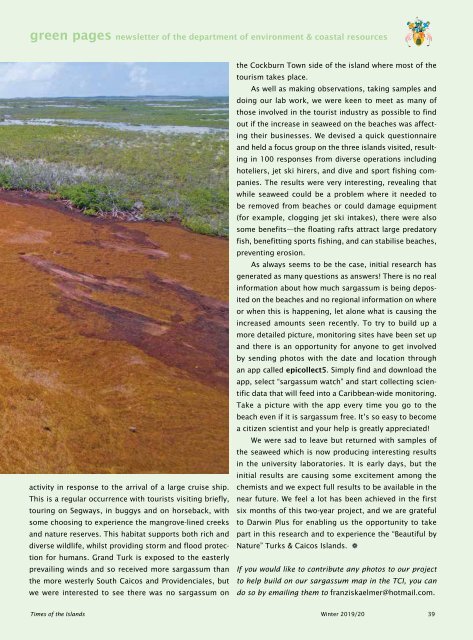Times of the Islands Winter 2019/20
Presents the "soul of the Turks & Caicos Islands" with in-depth features about local people, culture, history, environment, businesses, resorts, restaurants and activities.
Presents the "soul of the Turks & Caicos Islands" with in-depth features about local people, culture, history, environment, businesses, resorts, restaurants and activities.
You also want an ePaper? Increase the reach of your titles
YUMPU automatically turns print PDFs into web optimized ePapers that Google loves.
green pages newsletter <strong>of</strong> <strong>the</strong> department <strong>of</strong> environment & coastal resources<br />
activity in response to <strong>the</strong> arrival <strong>of</strong> a large cruise ship.<br />
This is a regular occurrence with tourists visiting briefly,<br />
touring on Segways, in buggys and on horseback, with<br />
some choosing to experience <strong>the</strong> mangrove-lined creeks<br />
and nature reserves. This habitat supports both rich and<br />
diverse wildlife, whilst providing storm and flood protection<br />
for humans. Grand Turk is exposed to <strong>the</strong> easterly<br />
prevailing winds and so received more sargassum than<br />
<strong>the</strong> more westerly South Caicos and Providenciales, but<br />
we were interested to see <strong>the</strong>re was no sargassum on<br />
<strong>the</strong> Cockburn Town side <strong>of</strong> <strong>the</strong> island where most <strong>of</strong> <strong>the</strong><br />
tourism takes place.<br />
As well as making observations, taking samples and<br />
doing our lab work, we were keen to meet as many <strong>of</strong><br />
those involved in <strong>the</strong> tourist industry as possible to find<br />
out if <strong>the</strong> increase in seaweed on <strong>the</strong> beaches was affecting<br />
<strong>the</strong>ir businesses. We devised a quick questionnaire<br />
and held a focus group on <strong>the</strong> three islands visited, resulting<br />
in 100 responses from diverse operations including<br />
hoteliers, jet ski hirers, and dive and sport fishing companies.<br />
The results were very interesting, revealing that<br />
while seaweed could be a problem where it needed to<br />
be removed from beaches or could damage equipment<br />
(for example, clogging jet ski intakes), <strong>the</strong>re were also<br />
some benefits—<strong>the</strong> floating rafts attract large predatory<br />
fish, benefitting sports fishing, and can stabilise beaches,<br />
preventing erosion.<br />
As always seems to be <strong>the</strong> case, initial research has<br />
generated as many questions as answers! There is no real<br />
information about how much sargassum is being deposited<br />
on <strong>the</strong> beaches and no regional information on where<br />
or when this is happening, let alone what is causing <strong>the</strong><br />
increased amounts seen recently. To try to build up a<br />
more detailed picture, monitoring sites have been set up<br />
and <strong>the</strong>re is an opportunity for anyone to get involved<br />
by sending photos with <strong>the</strong> date and location through<br />
an app called epicollect5. Simply find and download <strong>the</strong><br />
app, select “sargassum watch” and start collecting scientific<br />
data that will feed into a Caribbean-wide monitoring.<br />
Take a picture with <strong>the</strong> app every time you go to <strong>the</strong><br />
beach even if it is sargassum free. It’s so easy to become<br />
a citizen scientist and your help is greatly appreciated!<br />
We were sad to leave but returned with samples <strong>of</strong><br />
<strong>the</strong> seaweed which is now producing interesting results<br />
in <strong>the</strong> university laboratories. It is early days, but <strong>the</strong><br />
initial results are causing some excitement among <strong>the</strong><br />
chemists and we expect full results to be available in <strong>the</strong><br />
near future. We feel a lot has been achieved in <strong>the</strong> first<br />
six months <strong>of</strong> this two-year project, and we are grateful<br />
to Darwin Plus for enabling us <strong>the</strong> opportunity to take<br />
part in this research and to experience <strong>the</strong> “Beautiful by<br />
Nature” Turks & Caicos <strong>Islands</strong>. a<br />
If you would like to contribute any photos to our project<br />
to help build on our sargassum map in <strong>the</strong> TCI, you can<br />
do so by emailing <strong>the</strong>m to franziskaelmer@hotmail.com.<br />
<strong>Times</strong> <strong>of</strong> <strong>the</strong> <strong>Islands</strong> <strong>Winter</strong> <strong><strong>20</strong>19</strong>/<strong>20</strong> 39

















